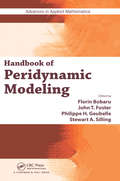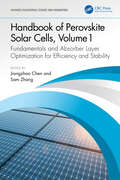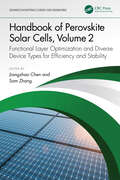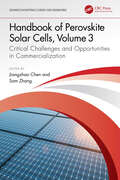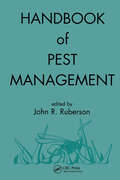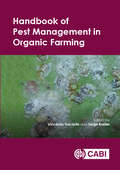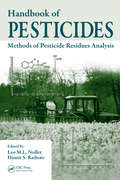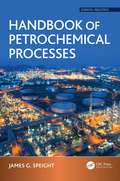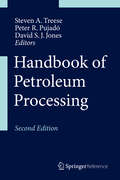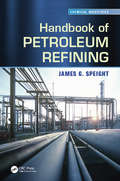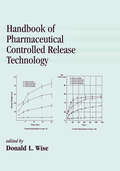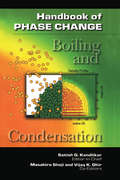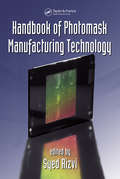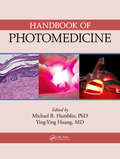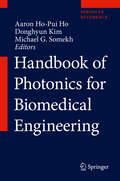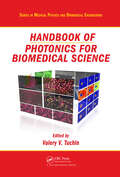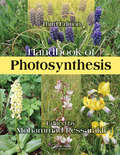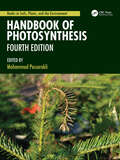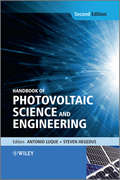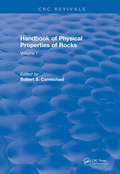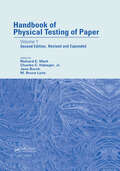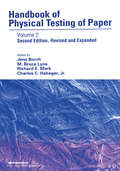- Table View
- List View
Handbook of Peridynamic Modeling (Advances in Applied Mathematics)
by Florin Bobaru John T. Foster Philippe H. Geubelle Stewart A. SillingThis handbook covers the peridynamic modeling of failure and damage. Peridynamics is a reformulation of continuum mechanics based on integration of interactions rather than spatial differentiation of displacements. The book extends the classical theory of continuum mechanics to allow unguided modeling of crack propagation/fracture in brittle, quasi-brittle, and ductile materials; autonomous transition from continuous damage/fragmentation to fracture; modeling of long-range forces within a continuous body; and multiscale coupling in a consistent mathematical framework.
Handbook of Perovskite Solar Cells, Volume 1: Fundamentals and Absorber Layer Optimization for Efficiency and Stability (ISSN)
by Sam Zhang Jiangzhao ChenOrganic–inorganic hybrid metal halide perovskite materials have attracted significant attention due to their advantages of low cost, tunable band gap, solution processing, high molar extinction coefficient, low exciton binding energy, and high carrier mobility. Perovskite absorber layers play a decisive role in the realization of high-power conversion efficiency in perovskite solar cells (PSCs). This book systematically and comprehensively discusses device structures, working principles, and optimization strategies of perovskite absorber layers for PSCs to help foster commercialization of these environmentally friendly power sources. It describes strategies to optimize the quality of perovskite films, including composition engineering, dimensional engineering, solvent engineering, strain engineering, additive engineering, and interface engineering.This volume: Introduces crystal structures of perovskites, configurations of PSCs, and their working principles Discusses the modulation of perovskite compositions and dimensionality towards highly stable and efficient perovskite photovoltaics Details the advancements of low-dimensional PSCs including phase stability of perovskite films and strategies for modulating phases Summarizes progress in solvent engineering, additive engineering, and strain engineering in efficient and scalable perovskite photovoltaics Describes the complex crystallization dynamics of perovskites, interface engineering, and synergistic modulation of grain boundaries and interfaces in PSCs Highlights advances in ion migration and mitigation in halide perovskite solar cells and origins and elimination of hysteresis This book is aimed at researchers, advanced students, and industry professionals in materials, energy, and related areas of engineering who are interested in development and commercialization of photovoltaic technologies.
Handbook of Perovskite Solar Cells, Volume 2: Functional Layer Optimization and Diverse Device Types for Efficiency and Stability (ISSN)
by Sam Zhang Jiangzhao ChenPerovskite solar cells (PSCs) have received significant attention in academia and industry due to their low cost and high-power conversion efficiency (PCE). Single- and multijunction PSCs have obtained promising certified PCEs, which suggests that PSCs are a very promising next-generation photovoltaic technology. In addition to the perovskite absorber layer, other functional layers, including electron transport layer (ETL), hole transport layer (HTL), and electrode layer (EL), have also made huge contributions to enhancing device performance. This book focuses on the development, advancement, and application of these functional layers in various PSCs.This volume: Introduces ETL, HTL, and EL in efficient and stable PSCs. Covers material properties. Discusses a wide variety of PSCs including single-crystal PSCs, flexible PSCs, perovskite tandem solar cells, lead-free PSCs, inorganic PSCs, fully printable mesoscopic PSCs, electron/hole-transport-layer-free PSCs, semitransparent PSCs for building-integrated photovoltaics (BIPV), tandem solar cells, perovskite indoor photovoltaics, and inverted PSCs. Details potential for commercial application. This book is aimed at researchers, advanced students, and industry professionals in materials, energy, and related areas of engineering who are interested in development and commercialization of photovoltaic technologies.
Handbook of Perovskite Solar Cells, Volume 3: Critical Challenges and Opportunities in Commercialization (ISSN)
by Sam Zhang Jiangzhao ChenPerovskite solar cells (PSCs) have emerged as one of the most promising new solar cells, with strong commercial potential. Several challenges remain before PSCs can be released in wide-scale commercial application. This book highlights the opportunities, advancements, and critical challenges involved in the commercial application of PSCs. It discusses large area fabrication, long-term stability, lead management, encapsulation techniques, as well as a commercial roadmap and current and future trends.This volume: Details the importance of lead management strategies to minimize toxicity. Shares progress on photon management. Discusses advances and challenges in enlarging perovskite use and the key factors restraining upscaling. Highlights issues around long-term stability of PSCs. Summarizes commercial advances around the industrialization of PSCs. This book is aimed at researchers, advanced students, and industry professionals in materials, energy, and related areas of engineering who are interested in development and commercialization of photovoltaic technologies.
Handbook of Pest Management
by John R. Ruberson"Provides a detailed summary of pest management principles and techniques, outlining a broad selection of critical issues regarding current practice and future technology in this area. Discusses the role of soils, weather, and surrounding habitats in regulating pest occurrence and severity."
Handbook of Pest Management in Organic Farming
by Vincenzo Vacante Serge KreiterThis book is an up-to-date and comprehensive reference covering pest management in organic farming in major crops of the world. General introductory chapters explore the management of crops to prevent pest outbreaks, plant protection tools in organic farming, and natural enemies and pest control. The remaining chapters are crop-based and discuss geographic distribution, economic importance and key pests. For each pest the fundamental aspects of its bio-ecology and the various methods of control are presented. Understanding of the scientific content is facilitated with practical advice, tables and diagrams, helping users to apply the theories and recommendations. Handbook of Pest Management in Organic Farming: - Consists of rational approaches and advice. - Is authored by a team of international specialists in pest control. - Represents the only available comprehensive review of insect pest management in organic systems. This is an essential resource for researchers and extension workers in crop protection, integrated pest management and biocontrol, and organic farming systems.
Handbook of Pest Management in Organic Farming (CABI Plant Protection Series)
by Jorge Peña Raija Komppula Beate Bursta Urs Niggli Massimo Benuzzi Gavino Delrio B. Merle Shepard Hüseyin Baspinar Carmelo Bonsignore Dominique Bordat Qiang Xiao Bernard Dufour Régis Babin Alberto Pantoja Josep Anton Jacas MiretThis book is an up-to-date and comprehensive reference covering pest management in organic farming in major crops of the world. General introductory chapters explore the management of crops to prevent pest outbreaks, plant protection tools in organic farming, and natural enemies and pest control. The remaining chapters are crop-based and discuss geographic distribution, economic importance and key pests. For each pest the fundamental aspects of its bio-ecology and the various methods of control are presented. Understanding of the scientific content is facilitated with practical advice, tables and diagrams, helping users to apply the theories and recommendations. Handbook of Pest Management in Organic Farming: · Consists of rational approaches and advice. · Is authored by a team of international specialists in pest control. · Represents the only available comprehensive review of insect pest management in organic systems. This is an essential resource for researchers and extension workers in crop protection, integrated pest management and biocontrol, and organic farming systems.
Handbook of Pesticides: Methods of Pesticide Residues Analysis
by Hamir Singh Rathore Leo M.L. NolletThis handbook provides a systematic description of the principles, procedures, and technology of the modern analytical techniques used in the detection, extraction, clean up, and determination of pesticide residues present in the environment. This book provides the historical background of pesticides and emerging trends in pesticide regulation. The
Handbook of Petrochemical Processes (Chemical Industries Ser.)
by James G. SpeightThe petrochemical industry is a scientific and engineering field that encompasses the production of a wide range of chemicals and polymers. The purpose of this book is not only to provide a follow-on to form the later chapters of the highly successful Chemistry and Technology of Petroleum 5th Edition but also provides a simplified approach to a very diverse chemical subject dealing with the chemistry and technology of various petroleum and petrochemical process. Following from the introductory chapters, this book provides the readers with a valuable source of information containing insights into petrochemical reactions and products, process technology, and polymer synthesis. Provides readers with a valuable source of information containing insights into petrochemical reactions and products, process technology, and polymer synthesis Introduces the reader to the various petrochemical intermediates are generally produced by chemical conversion of primary petrochemicals to form more complicated derivative products The reactions and processes involved in transforming petroleum-based hydrocarbons into the chemicals that form the basis of the multi-billion dollar petrochemical industry are reviewed and described The book includes information on new process developments for the production of raw materials and intermediates for petrochemicals Includes a description of the origin of the raw materials for the petrochemicals industry – including an overview of the coal chemicals industry
Handbook of Petroleum Processing
by Steven A. Treese Peter R. Pujadó David S. J. JonesThis extensively updated second edition of the already valuable reference targets research chemists and engineers who have chosen a career in the complex and essential petroleum industry, as well as other professionals just entering the industry who seek a comprehensive and accessible resource on petroleum processing. The handbook describes and discusses the key components and processes that make up the petroleum refining industry. Beginning with the basics of crude oils and their nature, it continues with the commercial products derived from refining and with related issues concerning their environmental impact. More in depth coverage of many topics previously covered in the first edition, such as hydraulic fracturing or fracking as it is often termed, help ensure this reference remains a relevant and up-to- date resource. At its core is a complete overview of the processes that make up a modern refinery, plus a brief history of the development of processes. Also described in detail are design techniques, operations and in the case of catalytic units, the chemistry of the reaction routes. These discussions are supported by calculation procedures and examples, which enable readers to use today's simulation-software packages. The handbook also covers off-sites and utilities, as well as environmental and safety aspects relevant to the industry. The chapter on refinery planning covers both operational planning and the decision making procedures for new or revamped processes. Major equipment used in the industry is reviewed along with details and examples of the process specifications for each. An extensive glossary and dictionary of the terms and expressions used in petroleum refining, plus appendices supplying data such as converging factors and selected crude oil assays, as well as an example of optimizing a refinery configuration using linear programming are all included to aid the reader. The 2nd edition of the Handbook of Petroleum Processing is an indispensable desk reference for chemists and engineers as well as an essential part of the libraries of universities with a chemical engineering faculty and oil refineries and engineering firms performing support functions or construction.
Handbook of Petroleum Refining (Chemical Industries #143)
by James G. SpeightPetroleum refining involves refining crude petroleum as well as producing raw materials for the petrochemical industry. This book covers current refinery processes and process-types that are likely to come on-stream during the next three to five decades. The book includes (1) comparisons of conventional feedstocks with heavy oil, tar sand bitumen, and bio-feedstocks; (2) properties and refinability of the various feedstocks; (3) thermal processes versus hydroprocesses; and (4) the influence of refining on the environment.
Handbook of Pharmaceutical Controlled Release Technology
by Donald L. WiseThe Handbook of Pharmaceutical Controlled Release Technology reviews the design, fabrication, methodology, administration, and classifications of various drug delivery systems, including matrices, and membrane controlled reservoir, bioerodible, and pendant chain systems.Contains cutting-edge research on the controlled delivery of biomolecules!
Handbook of Phase Change: Boiling and Condensation
by S.G. KandlikarProvides a comprehensive coverage of the basic phenomena. It contains twenty-five chapters which cover different aspects of boiling and condensation. First the specific topic or phenomenon is described, followed by a brief survey of previous work, a phenomenological model based on current understanding, and finally a set of recommended design equa
Handbook of Photomask Manufacturing Technology
by Syed RizviAs the semiconductor industry attempts to increase the number of functions that will fit into the smallest space on a chip, it becomes increasingly important for new technologies to keep apace with these demands. Photomask technology is one of the key areas to achieving this goal. Although brief overviews of photomask technology exist in the literature, the Handbook of Photomask Manufacturing Technology is the first in-depth, comprehensive treatment of existing and emerging photomask technologies available.The Handbook of Photomask Manufacturing Technology features contributions from 40 internationally prominent authors from industry, academia, government, national labs, and consortia. These authors discuss conventional masks and their supporting technologies, as well as next-generation, non-optical technologies such as extreme ultraviolet, electron projection, ion projection, and x-ray lithography. The book begins with an overview of the history of photomask development. It then demonstrates the steps involved in designing, producing, testing, inspecting, and repairing photomasks, following the sequences observed in actual production. The text also includes sections on materials used as well as modeling and simulation.Continued refinements in the photomask-making process have ushered in the sub-wavelength era in nanolithography. This invaluable handbook synthesizes these refinements and provides the tools and possibilities necessary to reach the next generation of microfabrication technologies.
Handbook of Photomedicine
by Michael R. Hamblin Ying-Ying HuangProviding the most comprehensive, up-to-date coverage of this exciting biomedical field, Handbook of Photomedicine gathers together a large team of international experts to give you a complete account of the application of light in healthcare and medical science. The book progresses logically from the history and fundamentals of photomedicine to di
Handbook of Photonics for Biomedical Engineering
by Donghyun Kim Aaron Ho-Pui Ho Michael G. SomekhNanophotonics has emerged rapidly into technological mainstream with the advent and maturity of nanotechnology available in photonics and enabled many new exciting applications in the area of biomedical science and engineering that were unimagined even a few years ago with conventional photonic engineering techniques. Handbook of Nanophotonics in Biomedical Engineering is intended to be a reliable resource to a wealth of information on nanophotonics that can inspire readers by detailing emerging and established possibilities of nanophotonics in biomedical science and engineering applications. This comprehensive reference presents not only the basics of nanophotonics but also explores recent experimental and clinical methods used in biomedical and bioengineering research. Each peer-reviewed chapter of this book discusses fundamental aspects and materials/fabrication issues of nanophotonics, as well as applications in interfaces, cell, tissue, animal studies, and clinical engineering. The organization provides quick access to current issues and trends of nanophotonic applications in biomedical engineering. All students and professionals in applied sciences, materials, biomedical engineering, and medical and healthcare industry will find this essential reference book highly useful.
Handbook of Photonics for Biomedical Science (Series in Medical Physics and Biomedical Engineering)
by Valery V. TuchinThe Handbook of Photonics for Biomedical Science analyzes achievements, new trends, and perspectives of photonics in its application to biomedicine. With contributions from world-renowned experts in the field, the handbook describes advanced biophotonics methods and techniques intensively developed in recent years.Addressing the latest problems in
Handbook of Photosynthesis (Books in Soils, Plants, and the Environment)
by Mohammad PessarakliSince the publication of the previous editions of the Handbook of Photosynthesis, many new ideas on photosynthesis have emerged in the past decade that have drawn the attention of experts and researchers on the subject as well as interest from individuals in other disciplines. Updated to include 37 original chapters and making extensive revisions to the chapters that have been retained, 90% of the material in this edition is entirely new. With contributions from over 100 authors from around the globe, this book covers the most recent important research findings. It details all photosynthetic factors and processes under normal and stressful conditions, explores the relationship between photosynthesis and other plant physiological processes, and relates photosynthesis to plant production and crop yields. The third edition also presents an extensive new section on the molecular aspects of photosynthesis, focusing on photosystems, photosynthetic enzymes, and genes. New chapters on photosynthesis in lower and monocellular plants as well as in higher plants are included in this section. The book also addresses growing concerns about excessive levels and high accumulation rates of carbon dioxide due to industrialization. It considers plant species with the most efficient photosynthetic pathways that can help improve the balance of oxygen and carbon dioxide in the atmosphere. Completely overhauled from its bestselling predecessors, the Handbook of Photosynthesis, Third Edition provides a nearly entirely new source on the subject that is both comprehensive and timely. It continues to fill the need for an authoritative and exhaustive resource by assembling a global team of experts to provide thorough coverage of the subject while focusing on finding solutions to relevant contemporary issues related to the field.
Handbook of Photosynthesis (Books in Soils, Plants, and the Environment)
by Mohammad PessarakliThe Fourth Edition of the Handbook of Photosynthesis offers a unique and comprehensive collection of topics in the field of photosynthesis, serving as an invaluable resource in this field. With contributions from 95 scientists and experts from over 20 countries, this volume has been divided into 13 parts, each serving independently to facilitate the understanding of the material.FEATURES Presents comprehensive information on photosynthesis under normal and environmental stress conditions Covers artificial photosynthesis and its future-related issues Contains 25 new chapters and 18 extensively revised and expanded chapters Includes three new sections: Influence of Nanoparticles on Photosynthesis; Protection of Photosynthesis System and Stress Alleviation Strategies by Photosynthates Manipulations and Photosynthesis Efficiency in Plants under Multiple Abiotic and Biotic Stressors; and Artificial Photosynthesis and Its Future Contains numerous tables, figures, illustrations, and case studies to facilitate the comprehension of the material as well as thousands of index words A primary resource in its field, Handbook of Photosynthesis, Fourth Edition, provides a comprehensive resource for researchers, academics, and for university courses, with the information as a valuable source to plan, implement, and evaluate strategies for dealing with photosynthesis issues.
Handbook of Photovoltaic Science and Engineering
by Antonio Luque Steven HegedusThe most comprehensive, authoritative and widely cited reference on photovoltaic solar energyFully revised and updated, the Handbook of Photovoltaic Science and Engineering, Second Edition incorporates the substantial technological advances and research developments in photovoltaics since its previous release. All topics relating to the photovoltaic (PV) industry are discussed with contributions by distinguished international experts in the field.Significant new coverage includes:three completely new chapters and six chapters with new authors device structures, processing, and manufacturing options for the three major thin film PV technologies high performance approaches for multijunction, concentrator, and space applications new types of organic polymer and dye-sensitized solar cells economic analysis of various policy options to stimulate PV growth including effect of public and private investment Detailed treatment covers:scientific basis of the photovoltaic effect and solar cell operation the production of solar silicon and of silicon-based solar cells and modules how choice of semiconductor materials and their production influence costs and performance making measurements on solar cells and modules and how to relate results under standardised test conditions to real outdoor performance photovoltaic system installation and operation of components such as inverters and batteries. architectural applications of building-integrated PV Each chapter is structured to be partially accessible to beginners while providing detailed information of the physics and technology for experts. Encompassing a review of past work and the fundamentals in solar electric science, this is a leading reference and invaluable resource for all practitioners, consultants, researchers and students in the PV industry.
Handbook of Physical Properties of Rocks: Volume I (CRC Press Revivals)
by Robert S. CarmichaelThis three-volume handbook provides reliable, comprehensive data on the properties of rocks, minerals, and other related materials. The format is largely tabular and graphical, designed for ease of use in comparisons and referencing. The chapters are contributed by recognized experts from leading university, industrial, and governmental scientific establishments.
Handbook of Physical Testing of Paper: Volume 1, Second Edition,
by Jens Borch M. Bruce Lyne Richard E. Mark Charles C. Habeger Koji MurakamiContains basic principles and the latest techniques in paper and paperboard testing. Fosters an understanding of theory and mechanical testing parameters to evaluate results and make improvements. Emphasizes new procedures utilizing advanced microscopy equipment.
Handbook of Physical Testing of Paper: Volume 2
by Jens Borch M. Bruce Lyne Richard E. Mark Charles C. HabegerThis handbook focuses on physical paper testing in the laboratory and online. Divided into five parts, it highlights assays for paper interactions with light, moisture, electricity, and heat. Topics expanded upon include laboratory testing procedures; microscopy analysis and paper surface properties; liquid and gas penetration; electrical and thermal interactions; and methods of surface characterization.
Handbook of Phytonutrients in Indigenous Fruits and Vegetables
by Rajeev Bhat Michael Rychlik Hosakatte Niranjana Murthy Fozia Homa Víctor M Jiménez Mohammad Akhtaruzzaman Stephen Akinola Saleha Akter Mohammad Khairul Alam Adeyemi Oladapo Aremu Manjeshwar Shrinath Baliga Harish Kumar Bastimal Amina Benabdallah Tania Chacón-Ordóñez N.N.G. Chiranthika Daniel Cozzolino Maral Seidi Damyeh Patricia Esquivel Héctor Estrada-Medina Olaniyi Amos Fawole Mohsina Ferdous Miriam Monserrat Ferrer Selina Fyfe Cyrielle Garcia Nadaraj Govender Prasanna P. Gunathilake Ummai Habiba Chafik Hdider H.A.C.O Hettiarachchi Lee-Hoon Ho Riadh Ilahy Beguvalli Subash Inchara Sheikh Nazrul Islam G. Janarny Eugénie Kayitesi Helyes Lajos Vimbainashe E. Manhivi Florence M. Mashitoa Petunia Mashiane Bárbara Paes Mata Patricia Irene Montañez-Escalante Niranjana Moorthi Isabela Jacob Moro Mack Moyo Siphosanele Mafa Moyo Adaucto Bellarmino Netto Gabi Netzel Dr Michael Netzel Olubukola Motunrayo Odeyemi Abiodun Olusola Omotayo Miriam Ferrer Ortega Karkala Sreedhara Pai Karkala Usha Pai Giriyapura Srikantachar Pavankumar Zoltán Pék Elisa Dos Pereira Adaucto B. Pereira-Netto Anh Dao Phan Charlotte Ralison Vonimatra Razafindrazaka María del Ruenes-Morales Luis Vitor Sacramento Mateus Kawata Salgaço André Gonzaga Santos Horst Joachim Schirra Dr Mohammed Wasim Siddiqui Faith Seke Ambreen Naz Shah Md. Tariqul Shajib Kátia Sivieri Heather E Smyth Sukirtha Srivarathan Thuan-Chew Tan Imen Tlili Annegowda Hardur Venkatappa Juliana Vinholes Márcia Vizzotto Olivia Wright Guggalada Govardhana YadavThe effects of inadequate diets on the population include malnutrition, non-communicable diseases and obesity. 'Hidden hunger', also known as micronutrient deficiencies, leads to various health-related disorders and diseases. Indigenous plants, in the form of indigenous fruits and leafy vegetables are gaining interest as a source of nutrients and bioactive phytochemicals, satisfying both food demand and health needs. Moreover, with the impact of climate change, and the importance of sustainability of food systems, it is essential that we investigate new, forgotten and alternative crops that can thrive in harsh conditions, require low fertilizer input, and are easily harvestable. This book contains chapters on 33 understudied indigenous fruits and vegetables from all around the world, including African nightshade, amaranth, baobab fruit, Indian gooseberry, red bush apple and snake melon. Each chapter provides: An overview of plant botany. An understanding of the phytonutrient constituents and health-promoting properties of bioactive compounds or metabolites. Information on the biological activity of the functional compounds that will improve productivity and increase utilization of indigenous fruits and vegetables to sustain food security. Impacts of postharvest storage, processing, and traditional food preparation methods. Potential for new product development. This is an essential resource for academic researchers and industry professionals in the fields of horticulture, agriculture, crop science, human health and nutrition.
Handbook of Pineapple Technology: Production, Postharvest Science, Processing and Nutrition
by Maria Gloria Lobo Robert E. PaullPineapple is the third most important tropical fruit in the world, with production occurring throughout the tropics. The demand for low acid fresh pineapples and its processed products is one of the fastest growing markets, especially in Europe and North America. This book provides an in depth and contemporary coverage of knowledge and practices in the value chain of this popular fruit, from production through to consumption. The chapters explore all the most recent developments in areas such as breeding, novel processing technologies, postharvest physiology and storage, packaging, nutritional quality and safety aspects. An outstanding team of authors from across the globe have contributed to make this the definitive pineapple handbook. Handbook of Pineapple Technology: Production, Postharvest Science, Processing and Nutrition is the ultimate guide for scientists in the food industries specializing in fruit processing, packaging and manufacturing. It is also a useful resource for educators and students of food technology and food sciences as well as research centers and regulatory agencies around the world.
